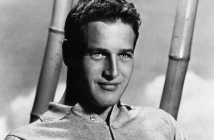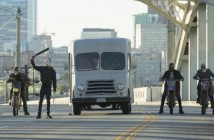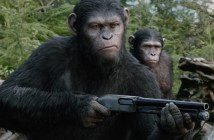
Editor’s Notes: Blue is the Warmest Color is now out in limited release.
Before the list, I want to make something clear. I’ve only seen 27 of the 57 winners of the Palm d’Or, so this is hardly a complete list. I’ve taken the top ten of the ones that I’ve seen which was still very difficult. So here are my top 10 Winners of the Palm d’Or from the Cannes Film Festival since 1955.
10. Fahrenheit 9/11 (Michael Moore, 2004)
The first and so far only documentary to win the Palm D’Or is as much a propaganda piece as it is a documentary. Moore sets out to dissuade voters in the 2004 US Presidential election from voting for incumbent President Bush. Not a pro-Kerry piece by any means, just an anti-Bush film that as reviled as it is in conservative circles, stands up to rigorous fact checking. Not as powerful now as it was 9 years ago (especially since Bush won re-election), but still some great filmmaking.

9. Farewell My Concubine (Chen Kaige, 1993)
I’ve already written a long piece for this film on this site, so I’ll make it brief. It’s the story of two Chinese opera performers throughout the ups and downs of their careers. The film is stunning to look at and offers some wonderful performances. Farewell, My Concubine is a shining example of the Chinese New Wave of the 90s.
8. Viridiana (Luis Bunuel, 1961)
Nearly any Bunuel is great Bunuel, but Viridiana is something else. It was the first film Bunuel had made in his native Spain since 1936, so of course he sets right in attacking the Catholic Church. Silvia Pinal plays the title character, a novice nun about to take her vows. She is urged to visit her only uncle (Fernando Rey) before taking her final vows. When she arrives, she finds that no good deed goes unpunished. One of Bunuel’s best.
7. La Dolce Vita (Federico Fellini, 1960)
One of Fellini’s most notorious films, La Dolce Vita is also an exercise in how much can be gotten away with without much of a plot. Fellini perfected that notion in his subsequent film, 8 ½ (1963). Here we get many eye-popping vistas and amazing vignettes and this is the film that the word ‘paparazzi’ comes from, derived from the name of an entertainment photographer Paparazzo. Though the film is long, it’s never boring but it could be described as a little indulgent.

6. The Leopard (Luciano Visconti, 1963)
This film deals with the end of the aristocratic society of Sicily in the 1860’s. It’s less the story than the performance by Burt Lancaster, who, even when dubbed into Italian, is magnetic and brilliant. The film is also sumptuously shot on location and features one of the most gorgeous set pieces in film history with the end banquet. See the restored 180 minute Italian version if you can, because the English-dubbed 160 minute version is good, but suffers from poor dubbing (they even dubbed Lancaster with a different voice!).
5. Taxi Driver (Martin Scorsese, 1976)
Martin Scorsese’s descent into madness is one of the finest films of his career of fine films. Scorsese shot this film in lurid colors and drenched it in Bernard Hermann’s final score and got from Robert DeNiro a performance that is comically terrifying. His awkwardness when interacting with people is tremendously funny, coupled with his decision to act on his violent urges makes his Travis Bickel one of the great screen characters and, despite the ending, completely unredeemable.
4. Kagemusha (Akira Kurosawa, 1980)
The film that is often (and unfairly) called a dry-run fro Ran (1985) is a masterpiece in its own right. With shades of The Prisoner of Zenda for a plot, Kurosawa creates one of the most stunning final battle sequences ever put to color film. Description is useless; one has to watch to understand the power and glory Kurosawa creates.
3. Pulp Fiction (Quentin Tarantino, 1994)
It’s strange to think that this film is 19 years old now, and that’s because it’s still as fresh and vital as it was then. With bravura performances and style to spare, both visually and written, Pulp Fiction has barely aged a day. Tarantino’s energy sets the tone for a slam-bang picture that spawned countless imitations but none anywhere near as well done. There are no missteps to be found in this film, despite it being Tarantino’s sophomore effort.

2. The Tree of Life (Terrence Malick, 2011)
How can something so recent be ranked ahead of these other films that have stood the test of nearly 20 years at the least? Simple: Malick crafted something that really has not been seen since Stanley Kubrick’s 2001: A Space Odyssey (1968) in that he made a film that relies more on interpretation and extrapolation than straight story. The Tree of Life is like an impressionistic painting where you understand what is going on more from the action that what is said (an idea Malick took even farther in his follow-up To The Wonder). I think that by the time this film turns 20 years old, it will be routinely listed as one of the best films ever made, just like Pulp Fiction is now.
1. Apocalypse Now (Francis Ford Coppola, 1979)
Coppola’s fourth and final masterpiece of the 1970’s (and second to win the Palm d’Or after The Conversation in 1974) depicts the horrors of the Vietnam War over the backdrop of Joseph Conrad’s novella Heart of Darkness. Coppola fought hard to get this vision to the screen, shooting for a year then editing for two more, he debuted the film at Cannes as a ‘work in progress’ that ended up winning. That, more than anything else, shows the power of this film. Even an unfinished print was better than anything else at the festival that year. Once seen, it is forever seared into your brain and never forgotten.



